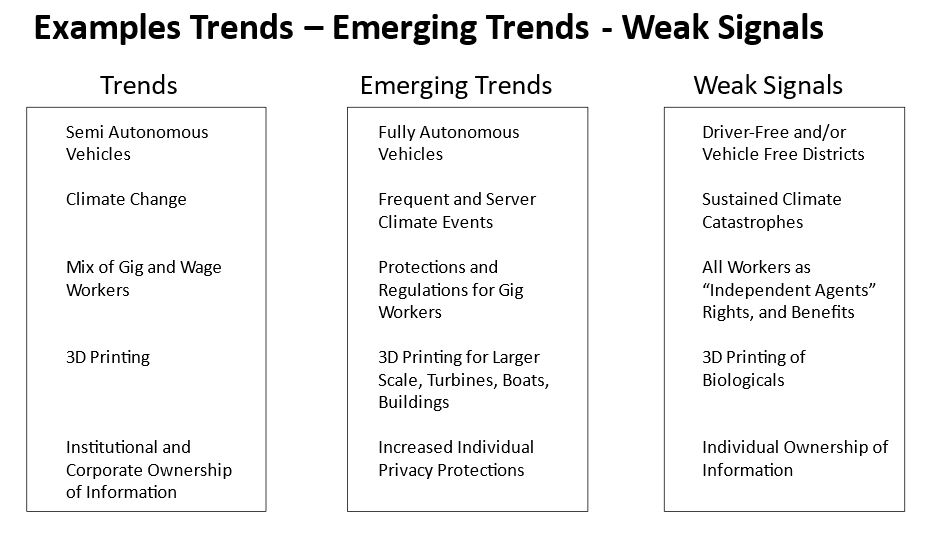- Navigator
- National
- Strategic Planning & Doing
Last month in the Navigator, Simon Anderson of Venture Foresight LLC and I laid out the case for how in an environment of constant and rapid change we need new approaches and tools for economic development planning and action. We introduced the approaches of applied foresight and adaptive planning. So, what is different about applied foresight and adaptive planning from what you may be doing now or have done in the past and how can you get started? A good place to start is with regard to how you consider past and recent trends as projections and how you can set a vision in times of great unknowns.
Thinking Beyond Recent Historic Tends: Emerging Trends and Weak Signals
Historically in economic development, we examine past and current situations and trends. When things have been stable and therefore predictable this has served us well. We analyze the current status and trends and draw on past and recent knowledge and best practices. However, when things are changing rapidly as they are today, the future is unpredictable. Past and recent trends may not apply and if we base our strategies and actions on them, they can mislead us. They should still be assessed and considered in terms of implications because they may and often do continue for some time; however, to be adaptive we must go further and deeper into examining and preparing for future possibilities. This is where emerging trends and weak signals come in.
- Trends: It has and is happening – How intense is it; how long will it continue?
- Emerging Trends: It is starting to happen – Will it continue to become a trend?
- Weak Signals: There seems to be something out there – It may or may not happen – What might it be? How can we better explore possibilities and better be prepared?
All trends were once emerging trends and before they were, there were small signs that something might be beyond the horizon, but we cannot be sure what it is or how to analyze it. The World Wide Web is a prime example. Few people understood how it would come to impact all that we do and all of our economy when it was created in 1983. Many likely believed it would fade away or be limited in its applications.
A good exercise to integrate strategic foresight and adaptive planning into the process of planning and acting for economic development is to brainstorm current trends, then identify trends that might be emerging, then possible weak signals. This can be done through a combination of research and information gathering along with group engagement. An example of what results might look like is as follows:

These results can then be integrated into the adaptive planning process to develop strategies and actions to build capacities to handle challenges and leverage opportunities.
Principles and Values to Drive Vision
Rapid change combined with greater diversity and complexity within communities, networks, and systems requires new approaches to “visioning” within planning. Everyone knowing what is likely coming in terms of issues, opportunities and consequences is increasingly difficult. Everyone agreeing and having the same and clear vision is often unachievable and insisting on it will get you stuck in the process leading to inaction or resulting in a “watered down /meaningless” vision statement that motivates no one. Focusing on principles to drive vision can help get you unstuck.
To do this we need a process to:
- Dialogue to understand the values and principles of community
- Define as clear and best you can collectively with examples and stories
- Apply as a filter to strategies, actions, and initiative, development
We start by asking, engaging, and dialoguing on:
- How do you want to act? What values do you want to be guided by?
- What do you want your “connective character” to be?
- Vision – What does success looks like X years and beyond?
Then, we filter the planning process, actions, and outcomes through these values and vision.
As an example: “We value and will be guided by:”
- Individual and collective health and wellness
- Trustworthiness, honesty, transparency
- Diversity and inclusiveness
- Community connections/family/belonging
- Innovation
- Grit/tenacity/determination
- Sustainable – Balance of environment and economics
Focused/efficient - Collaborative
- Culture of continuous/learning/educating
It is important to note that these are examples only! They must be determined by and fit your environment and those within it! We take these often-vague principle/value concepts and further clarify and understand meanings and connections for participants by asking:
- When applying these principles and values look and feel like?
- Further describe the experience of these principles and values – How do they look and feel –using words, examples, pictures, graphics, whatever?
- Share and engage – What are others hearing/seeing? Can they relate and connect? How would they describe? What are their stories and examples?
Through this process, we seek to synthesize and clarify. But we are not done! To further clarify, connect and synthesize so they can be applied we must envision what we hope these synthesized principles and values can achieve (their desired outcomes) by asking:
- Connect principles and values to outcomes – State, explain, describe these outcomes
- Share and engage
- Synthesize and clarify
The results become our statements of principles and values to drive vision or visions throughout the adaptive planning process. There is no one correct final format. The statement of vision can be very simple. For example: “an economy that creates and supports opportunities for the wellbeing of communities and people”. Or there can be multiple vision statements. Importantly, complete consensus need not be attained on every statement! Tensions and various preferences can remain as long as they are expressed and understood and trust in the process going forward is fostered.
Interested in learning more about and integrating applied foresight and adaptive planning for economic development?
Feel free to reach out with questions to jim@camoinassociates.com and check out the online course we developed to get you started. For Navigator readers, we extend a $50 discount for the course. https://www.futurereadyeconomy.com/course?coupon=NAVIGATOR50OFF





